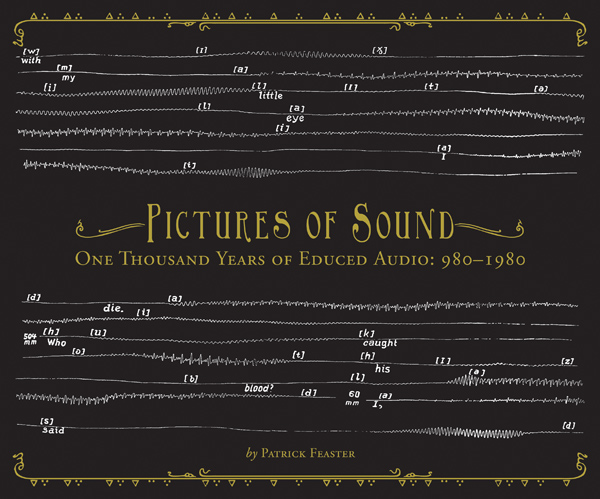Patrick Feaster: Pictures of Sound: One Thousand Years of Educed Audio, 980-1980 + CD (2012)
Filed under book, sound recording | Tags: · history of technology, media archeology, phonograph, sound, sound recording, technology

“Using modern technology, Patrick Feaster is on a mission to resurrect long-vanished voices and sounds—many of which were never intended to be revived.
Over the past thousand years, countless images have been created to depict sound in forms that theoretically could be “played” just as though they were modern sound recordings. Now, for the first time in history, this compilation uses innovative digital techniques to convert historic “pictures of sound” dating back as far as the Middle Ages directly into meaningful audio. It contains the world’s oldest known “sound recordings” in the sense of sound vibrations automatically recorded out of the air—the groundbreaking phonautograms recorded in Paris by Édouard-Léon Scott de Martinville in the 1850s and 1860s—as well as the oldest gramophone records available anywhere for listening today, including inventor Emile Berliner’s recitation of Der Handschuh, played back from an illustration in a magazine, which international news media recently proclaimed to be the oldest audible “record” in the tradition of 78s and vintage vinyl. Other highlights include the oldest known recording of identifiable words spoken in the English language (1878) and the world’s oldest surviving “trick recording” (1889). But Pictures of Sound pursues the thread even further into the past than that by “playing” everything from medieval music manuscripts to historic telegrams, and from seventeenth-century barrel organ programs to eighteenth-century “notations” of Shakespearean recitation.
In short, this isn’t just another collection of historical audio—it redefines what “historical audio” is.”
Publisher Dust-to-Digital, Atlanta/GA, 2012
144 pages, with 164 images
via prohairesis
Review: Randall Roberts (LA Times).
FirstSounds.org initiative
Patrick Feaster discusses Pictures of Sound (video, 36 min)
Author
Publisher
PDF, PDF (29 MB, updated on 2018-3-29)
ZIP (CD, 92 MB, ZIP’d OGG, updated on 2016-12-23)
John M. Picker: Victorian Soundscapes (2003)
Filed under book | Tags: · 1800s, acoustics, history of literature, listening, literature, music, noise, phonograph, recording, silence, sound, sound recording, united kingdom, voice

“Far from the hushed restraint we associate with the Victorians, their world pulsated with sound. This book shows how, in more ways than one, Victorians were hearing things. The representations close listeners left of their soundscapes offered new meanings for silence, music, noise, voice, and echo that constitute an important part of the Victorian legacy to us today. In chronicling the shift from Romantic to modern configurations of sound and voice, Picker draws upon literary and scientific works to recapture the sense of aural discovery figures such as Babbage, Helmholtz, Freud, Bell, and Edison shared with the likes of Dickens, George Eliot, Tennyson, Stoker, and Conrad.”
Publisher Oxford University Press, 2003
ISBN 0195151917, 9780195151916
220 pages
PDF, PDF (updated on 2017-3-2)
Comments (4)Alex Sayf Cummings: Democracy of Sound: Music Piracy and the Remaking of American Copyright in the Twentieth Century (2013)
Filed under book | Tags: · copyright, counterculture, intellectual property, law, music, new media, phonograph, piracy

“It was a time when music fans copied and traded recordings without permission. An outraged music industry pushed Congress to pass anti-piracy legislation. Yes, that time is now; it was also the era of Napster in the 1990s, of cassette tapes in the 1970s, of reel-to-reel tapes in the 1950s, even the phonograph epoch of the 1930s. Piracy, it turns out, is as old as recorded music itself.
In Democracy of Sound, Alex Sayf Cummings uncovers the little-known history of music piracy and its sweeping effects on the definition of copyright in the United States. When copyright emerged, only visual material such as books and maps were thought to deserve protection; even musical compositions were not included until 1831. Once a performance could be captured on a wax cylinder or vinyl disc, profound questions arose over the meaning of intellectual property. Is only a written composition defined as a piece of art? If a singer performs a different interpretation of a song, is it a new and distinct work? Such questions have only grown more pressing with the rise of sampling and other forms of musical pastiche. Indeed, music has become the prime battleground between piracy and copyright. It is compact, making it easy to copy. And it is highly social, shared or traded through social networks–often networks that arise around music itself. But such networks also pose a counter-argument: as channels for copying and sharing sounds, they were instrumental in nourishing hip-hop and other new forms of music central to American culture today. Piracy is not always a bad thing.
An insightful and often entertaining look at the history of music piracy, Democracy of Sound offers invaluable background to one of the hot-button issues involving creativity and the law.
– Provides a political and historical perspective on the rise of the “information economy.”
– Discusses rare and little-known unreleased songs by the Beatles, which are potentially controversial because of their racial content.
– Shows how piracy has been integral to the music industry through much of its history and how pirates have influenced copyright law.”
Publisher Oxford University Press, 2013
ISBN 0199858225, 9780199858224
336 pages

